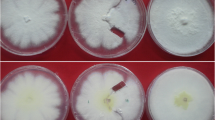Summary
Oospore formation in paired cultures with various combinations of six isolates of Phytophthora species were studied.
Three of these isolates belong toP. palmivora and the three others toP. faberi, P. meadii andP. arecae respectively.
P. arecae was found to produce oospores withP. meadii, P. palmivora andP. faberi.
P. arecae therefore falls into Gadd’s “rubber” group andP. meadii into the “cacao” group.
Ashby’s second grouping to accommodateP. arecae andP. meadii is superfluous.
The formation of oospores in combinations ofP. arecae withP. meadii or any one of the members of the “cacao” group lends additional support for merging all these isolates as strains ofPhytophthora palmivora.
Similar content being viewed by others
References
Ashby, S. F. “Oospores in cultures ofPhytophthora faberi,” Kew Bull. Misc. Information, 1922, 257–62.
— “Strains and taxonomy ofPhytophthora palmivora Butler,”Trans. Brit. Myc. Soc., 1929 (1),14, 18–38.
— “Further note on the production of sexual organs in paired cultures of species and strains of Phytophthora,” —, 1929 (2),14, 254–60.
Clinton, G. P. “Oospores of the Potato blight,Phytophthora infestons,” Rept. Conn. Agric. Expt. Stn., 1909–10, 753–54.
Gadd, C. B. “Phytophthorafaberi Maubl.,”Ann. Roy. Bot. Gard. Peradeniya, 1924,1, 47–89.
— “The relationship between the Phytophthoræ associated with the bud rot diseases of palms,”Ann. Bot., 1927,41, 253–80.
Kheshwalla, F. F. “Seedling blight ofCinchona ledgeriana Moens caused byPhytophthora palmivora Butl. in the Darjeeling District,”Ind. Jour. Agr. Sci., 1935,5, 485–95.
Lester-Smith, W. C. “Some observations on the oospores of Phytophthora species,Ann. Roy. Bot. Gard. Peradeniya, 1927,10, 243–57.
Narasimhan, M. J. “Studies in the genusPhytophthora in Mysore—I. Heterothallic strain ofPhytophthora,”Phytopath., 1930,20, 201–14.
Tucker, C. M. “Taxonomy of the GenusPhytophthora de Bary.,”Agr. Exp. Stn. Missouri Res. Bull., 1931,153.
Uppal, B. N., and Desai, M. K. “Koleroga disease of arecanut,”Curr. Sci.,8, 1939, 122–24.
Venkatarayan, S.V. “Phytophthoraarecae on areca tops and a strain ofP. palmivora (P. faberi) on a new host,Aleurites fordi,”Phytopath., 1932,22, 217–27.
Author information
Authors and Affiliations
Additional information
Communicated by Mr. V. Ramanatha Ayyar, Cotton Specialist, Coimbatore
I wish to express my indebtedness to Mr. K. M. Thomas, Government Mycologist, for help and advice during the course of the work and in the preparation of this paper.
Rights and permissions
About this article
Cite this article
Marudarajan, D. Observations on the production of sexual organs in paired cultures of phytophthora species of the palmivora group. Proc. Indian Acad. Sci. 14, 384–389 (1941). https://doi.org/10.1007/BF03051149
Received:
Issue Date:
DOI: https://doi.org/10.1007/BF03051149




